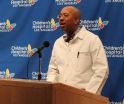(Press-News.org) A once fertile landmass now submerged beneath the Persian Gulf may have been home to some of the earliest human populations outside Africa, according to an article published today in Current Anthropology.
Jeffrey Rose, an archaeologist and researcher with the University of Birmingham in the U.K., says that the area in and around this "Persian Gulf Oasis" may have been host to humans for over 100,000 years before it was swallowed up by the Indian Ocean around 8,000 years ago. Rose's hypothesis introduces a "new and substantial cast of characters" to the human history of the Near East, and suggests that humans may have established permanent settlements in the region thousands of years before current migration models suppose.
In recent years, archaeologists have turned up evidence of a wave of human settlements along the shores of the Gulf dating to about 7,500 years ago. "Where before there had been but a handful of scattered hunting camps, suddenly, over 60 new archaeological sites appear virtually overnight," Rose said. "These settlements boast well-built, permanent stone houses, long-distance trade networks, elaborately decorated pottery, domesticated animals, and even evidence for one of the oldest boats in the world."
But how could such highly developed settlements pop up so quickly, with no precursor populations to be found in the archaeological record? Rose believes that evidence of those preceding populations is missing because it's under the Gulf.
"Perhaps it is no coincidence that the founding of such remarkably well developed communities along the shoreline corresponds with the flooding of the Persian Gulf basin around 8,000 years ago," Rose said. "These new colonists may have come from the heart of the Gulf, displaced by rising water levels that plunged the once fertile landscape beneath the waters of the Indian Ocean."
Historical sea level data show that, prior to the flood, the Gulf basin would have been above water beginning about 75,000 years ago. And it would have been an ideal refuge from the harsh deserts surrounding it, with fresh water supplied by the Tigris, Euphrates, Karun, and Wadi Baton Rivers, as well as by underground springs. When conditions were at their driest in the surrounding hinterlands, the Gulf Oasis would have been at its largest in terms of exposed land area. At its peak, the exposed basin would have been about the size of Great Britain, Rose says.
Evidence is also emerging that modern humans could have been in the region even before the oasis was above water. Recently discovered archaeological sites in Yemen and Oman have yielded a stone tool style that is distinct from the East African tradition. That raises the possibility that humans were established on the southern part of the Arabian Peninsula beginning as far back as 100,000 years ago or more, Rose says. That is far earlier than the estimates generated by several recent migration models, which place the first successful migration into Arabia between 50,000 and 70,000 years ago.
The Gulf Oasis would have been available to these early migrants, and would have provided "a sanctuary throughout the Ice Ages when much of the region was rendered uninhabitable due to hyperaridity," Rose said. "The presence of human groups in the oasis fundamentally alters our understanding of human emergence and cultural evolution in the ancient Near East."
It also hints that vital pieces of the human evolutionary puzzle may be hidden in the depths of the Persian Gulf.
###
Jeffrey I. Rose, "New Light on Human Prehistory in the Arabo-Persian Gulf Oasis." Current Anthropology 51:6 (December 2010).
Current Anthropology is a transnational journal devoted to research on humankind, encompassing the full range of anthropological scholarship on human cultures and on the human and other primate species. The journal is published by The University of Chicago Press and sponsored by the Wenner-Gren Foundation for Anthropological Research.
Lost civilization under Persian Gulf?
2010-12-09
ELSE PRESS RELEASES FROM THIS DATE:
Reproductive scientists create mice from 2 fathers
2010-12-09
Using stem cell technology, reproductive scientists in Texas, led by Dr. Richard R. Berhringer at the M.D. Anderson Cancer Center, have produced male and female mice from two fathers.
The study was posted today (Wednesday, December 8) at the online site of the journal Biology of Reproduction.
The achievement of two-father offspring in a species of mammal could be a step toward preserving endangered species, improving livestock breeds, and advancing human assisted reproductive technology (ART). It also opens the provocative possibility of same-sex couples having their ...
New pictures show fourth planet in giant version of our solar system
2010-12-09
LIVERMORE, Calif. – Astronomers have discovered a fourth giant planet, joining three others that, in 2008, were the subject of the first-ever pictures of a planetary system orbiting another star other than our sun.
The solar system, discovered by a team from Lawrence Livermore National Laboratory and the National Research Council of Canada (NRC) Herzberg Institute of Astrophysics with collaborators at University of California, Los Angeles and Lowell Observatory, orbits around a dusty young star named HR8799, which is 129 light years away. All four planets are roughly ...
School-based program effective in helping adolescents
2010-12-09
(New York, December 8, 2010) – A school-based intervention program helped New York City high school students with moderate to severe asthma better manage their symptoms, dramatically reducing the need for urgent care, including hospitalizations and emergency room visits, according to a study published online in the American Journal of Respiratory and Critical Care Medicine.
Students in the eight-week program reported a 28% reduction in acute medical visits, a 49% reduction in emergency department visits, and a 76% reduction in hospitalizations compared with asthmatic ...
Older survivors of mechanical ventilation can expect significant disability
2010-12-09
Patients aged 65 and older who survive an episode of mechanical ventilation during a hospitalization are more likely to suffer from long-term disabilities after leaving the hospital than those who survive hospitalization without mechanical ventilation, according to researchers at the University of Pittsburgh. These results were borne out even though the levels of functional disability prior to hospitalization were similar in both groups.
The study was published online ahead of the print edition of the American Thoracic Society's American Journal of Respiratory and Critical ...
Autism breakthrough: Researchers identify possible treatment for impaired sociability
2010-12-09
NORFOLK, Va. – Eastern Virginia Medical School researchers have identified a potential novel treatment strategy for the social impairment of people with Autism Spectrum Disorders (ASD), an aspect of the condition that has a profound impact on quality of life.
"Persons with Autism Spectrum Disorders are either disinterested in social interactions or find them unpleasant. They often don't understand what other people are thinking or feeling and misinterpret social cues," said Stephen I. Deutsch, MD, PhD, the Ann Robinson Chair and professor of psychiatry and behavioral ...
World's first microlaser emitting in 3-D
2010-12-09
WASHINGTON, Dec. 8 – Versatile electronic gadgets should employ a number of important criteria: small in size, quick in operation, inexpensive to fabricate, and deliver high precision output. A new microlaser, developed at the Jožef Stefan Institute in Ljubljana, Slovenia embodies all these qualities. It is small, tunable, cheap, and is essentially the world's first practical three-dimensional laser.
As described in Optics Express, an open-access journal published by the Optical Society (OSA), Slovenian scientists Matjaž Humar and Igor Muševič have developed a microdroplet ...
Carbon-rich planet: A girl's best friend?
2010-12-09
A peculiar gas-giant planet orbiting a sun-like star 1200 light-years away is the first carbon-rich world ever observed.
The implications are big for planetary chemistry, because without much oxygen, common rocks throughout the planet would be made of pure carbon, in forms such as diamonds or graphite.
"On most planets, oxygen is abundant. It makes rocks such as quartz and gases such as carbon dioxide," said University of Central Florida professor Joseph Harrington, one of the study's lead researchers. "With more carbon than oxygen, you would get rocks of pure carbon, ...
Greenland ice sheet flow driven by short-term weather extremes, not gradual warming: UBC research
2010-12-09
Sudden changes in the volume of meltwater contribute more to the acceleration – and eventual loss – of the Greenland ice sheet than the gradual increase of temperature, according to a University of British Columbia study.
The ice sheet consists of layers of compressed snow and covers roughly 80 per cent of the surface of Greenland. Since the 1990s, it has been documented to be losing approximately 100 billion tonnes of ice per year – a process that most scientists agree is accelerating, but has been poorly understood. Some of the loss has been attributed to accelerated ...
Astronomers discover, image new planet in planetary system very similar to our own
2010-12-09
An international team of astronomers has discovered and imaged a fourth giant planet outside our solar system, a discovery that further strengthens the remarkable resemblances between a distant planetary system and our own.
The research is published Dec. 8 in the advance online version of the journal Nature.
The astronomers say the planetary system resembles a supersized version of our solar system.
"Besides having four giant planets, both systems also contain two 'debris belts' composed of small rocky or icy objects, along with lots of tiny dust particles," ...
Trauma surgeon leads call to action for pediatric applied trauma research network
2010-12-09
LOS ANGELES (December 8, 2010) – Jeffrey S. Upperman, MD, director of the Trauma Program at Children's Hospital Los Angeles, has co-authored a call to action for filling a significant gap in pediatric public health care and seeks federal oversight to establish the framework for a pediatric applied trauma research network (PATRN). This call to action was published simultaneously in the Journal of Pediatric Surgery and the Journal of Trauma.
"The establishment of a pediatric trauma research network will be an important advance in trauma care in the U.S.," said Dr. Upperman. ...

